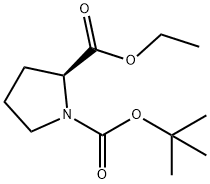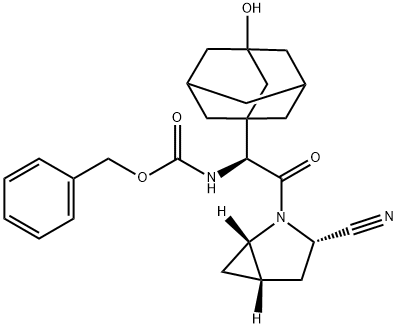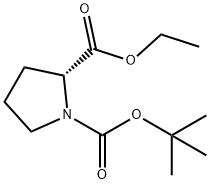Saxagliptin hydrochloride
- CAS NO.:709031-78-7
- Empirical Formula: C18H25N3O2.HCl
- Molecular Weight: 351.88
- MDL number: MFCD22572334
- EINECS: 696-124-3
- SAFETY DATA SHEET (SDS)
- Update Date: 2025-08-06 15:14:14

What is Saxagliptin hydrochloride?
Description
Saxagliptin (709031-78-7) is a clinically useful DPPIV inhibitor for the treatment of diabetes.1 ?Human DPP-IV Ki = 0.6 nM.2
The Uses of Saxagliptin hydrochloride
Saxagliptin is a potent and selective reversible inhibitor of dipeptidyl peptidase-4, which is being developed for the treatment of type 2 diabetes. It is absorbed rapidly after oral administration and has a pharmacokinetic profile compatible with once daily dosing.
Storage
Store at -20°C
References
Tahrani et al. (2009) Saxagliptin: a new DPP-4 inhibitor for the treatment of type 2 diabetes mellitus; Adv. Ther. 26 249 Augeri et al. (2005) Discovery and Preclinical Profile of Saxagliptin (BMS-477118): A Highly Potent, Long-Acting, Orally Active Dipeptidyl Peptidase IV Inhibitor for the Treatment of Type 2 Diabetes; J. Med. Chem. 48 5025
Properties of Saxagliptin hydrochloride
| Melting point: | >219°C |
| storage temp. | -20°C |
| solubility | Soluble in DMSO (20 mg/ml) |
| form | solid |
| color | White |
| Stability: | Stable for 1 year as supplied. Solutions in DMSO may be stored at -20°C for up to 3 months. |
Safety information for Saxagliptin hydrochloride
Computed Descriptors for Saxagliptin hydrochloride
| InChIKey | TUAZNHHHYVBVBR-PMEPUXBANA-N |
| SMILES | [C@@H](C12CC3CC(CC(C3)(O)C1)C2)(N)C(N1[C@@H](C[C@@H]2C[C@H]12)C#N)=O.Cl |&1:0,15,17,19,r| |
Saxagliptin hydrochloride manufacturer
Archerchem Healthcare Pvt., Ltd. (part of Archerchem Group)
Bazayan & Co.
New Products
4,4-Difluoropiperidine hydrochloride tert-butyl 9-methoxy-3-azaspiro[5.5]undecane-3-carboxylate Indole Methyl Resin N-Isopropylurea N,N-Dicyclohexylcarbodiimide(DCC) MELDRUMS ACID 5-METHYLISOXAZOLE-4-CARBOXYLIC ACID Magnessium Bis glycinate Zinc ascorbate 1-bromo-2-butyne 2-acetamidophenol 9(10H)-anthracenone Erythrosin B, 4-Piperidinopiperidine 2-((4-morpholinophenylamino) (methylthio) methylene) malononitrile 2,4-dihydroxybenzaldehyde 3-(4-morpholinophenylamino)-5-amino-1H-pyrazole-4-carbonitrile Methyl 2-methylquinoline-6-carboxylate 2,6-dichloro-4-nitropyridine 4-Bromo-2-chlorobenzonitrile 2-(benzylamino)acetic acid hydrochloride 4-(tert-Butoxycarbonylamino)but- 2-ynoic acid 3,4-dihydro-2H-benzo[b][1,4]dioxepine 1-Phenyl-1-cycloprppanecarboxylicacidRelated products of tetrahydrofuran

![[15N,2H2]-Saxagliptin Hydrochloride](https://img.chemicalbook.in/)
![AcetaMide, N-[(1S)-2-[(1S,3S,5S)-3-cyano-2-azabicyclo[3.1.0]hex-2-yl]-1-(3-hydroxytricyclo[3.3.1.13,7]dec-1-yl)-2-oxoethyl]-2,2,2-trifluoro-](https://img.chemicalbook.in/CAS/20210111/GIF/865999-70-8.gif)
![2-Azabicyclo[3.1.0]hexane-3-carbonitrile, 2-[(2R)-2-aMino-2-(3-hydroxytricyclo[3.3.1.13,7]dec-1-yl)acetyl]-, (1S,3R,5S)-](https://img.chemicalbook.in/CAS/20200611/GIF/1564266-03-0.gif)

![(1S,3S,5S)-2-(TERT-BUTOXYCARBONYL)-2-AZABICYCLO[3.1.0]HEXANE-3-CARBOXYLIC ACID](https://img.chemicalbook.in/StructureFile/ChemBookStructure20/GIF/CB2825254.gif)


You may like
-
 Saxagliptin hydrochloride 98%View Details
Saxagliptin hydrochloride 98%View Details -
 709031-78-7 98%View Details
709031-78-7 98%View Details
709031-78-7 -
 Saxagliptin hydrochloride 99%View Details
Saxagliptin hydrochloride 99%View Details
709031-78-7 -
 Saxagliptin hydrochloride 709031-78-7 99%View Details
Saxagliptin hydrochloride 709031-78-7 99%View Details
709031-78-7 -
 Saxagliptin hydrochloride 95% CAS 709031-78-7View Details
Saxagliptin hydrochloride 95% CAS 709031-78-7View Details
709031-78-7 -
 20677-73-0 (2,2-diethoxyethyl)methylamine 98%View Details
20677-73-0 (2,2-diethoxyethyl)methylamine 98%View Details
20677-73-0 -
 3-(4-(hydroxyamino)-1-oxoisoindolin-2-yl)piperidine-2,6-dione 98%View Details
3-(4-(hydroxyamino)-1-oxoisoindolin-2-yl)piperidine-2,6-dione 98%View Details -
 57381-49-4 2-bromo-4-chlorobenzonitrile 98%View Details
57381-49-4 2-bromo-4-chlorobenzonitrile 98%View Details
57381-49-4
